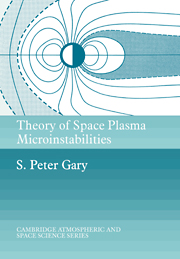Book contents
- Frontmatter
- Contents
- Preface
- 1 Introduction
- 2 Electrostatic waves in uniform plasmas
- 3 Electrostatic component/component instabilities in uniform plasmas
- 4 Electrostatic drift instabilities in inhomogeneous plasmas
- 5 Electromagnetic fluctuations in uniform plasmas
- 6 Electromagnetic waves in uniform plasmas
- 7 Electromagnetic temperature anisotropy instabilities in uniform plasmas
- 8 Electromagnetic component/component instabilities in uniform plasmas
- Appendix A The plasma dispersion function
- Appendix B Unperturbed orbits
- Appendix C Integral evaluation
- Index of symbols
- Index
3 - Electrostatic component/component instabilities in uniform plasmas
Published online by Cambridge University Press: 06 November 2009
- Frontmatter
- Contents
- Preface
- 1 Introduction
- 2 Electrostatic waves in uniform plasmas
- 3 Electrostatic component/component instabilities in uniform plasmas
- 4 Electrostatic drift instabilities in inhomogeneous plasmas
- 5 Electromagnetic fluctuations in uniform plasmas
- 6 Electromagnetic waves in uniform plasmas
- 7 Electromagnetic temperature anisotropy instabilities in uniform plasmas
- 8 Electromagnetic component/component instabilities in uniform plasmas
- Appendix A The plasma dispersion function
- Appendix B Unperturbed orbits
- Appendix C Integral evaluation
- Index of symbols
- Index
Summary
This chapter begins our consideration of instabilities, plasma modes that grow in time or space. The source of growth of a plasma microinstability is what is imprecisely called “free energy:” an anisotropy or inhomogeneity in the zeroth-order velocity distribution function. In this chapter we consider free energy sources associated with the relative drifts of plasma components, and find that different types of relative drifts each can give rise to several different unstable modes.
As in Chapter 2, we consider uniform collisionless plasmas in which the evolution of the distribution function of the jth component is described by the Vlasov equation (1.3.2). Again we restrict ourselves to electrostatic fluctuations; that is, we assume there are no fluctuating magnetic fields and the fluctuating electric fields are derived from Poisson's equation (1.2.4). In Section 3.1 we state zeroth-order distribution functions representing several different free energy sources. Section 3.2 considers electrostatic instabilities driven by component/component relative drifts in unmagnetized plasmas and Section 3.3 considers electrostatic instabilities driven by the same free energy sources in magnetized plasmas. Throughout this chapter, we assume the plasma to be charge neutral and to bear no steady-state electric field.
Although virtually all space plasmas bear ambient magnetic fields, some waves and instabilities have properties that are essentially independent of B0. In Section 3.3 we demonstrate this by showing that the magnetized electrostatic dispersion equation at k × B0 = 0 reduces to the unmagnetized form.
- Type
- Chapter
- Information
- Theory of Space Plasma Microinstabilities , pp. 30 - 66Publisher: Cambridge University PressPrint publication year: 1993
- 1
- Cited by



